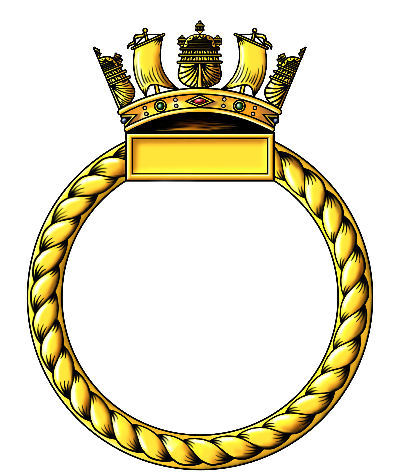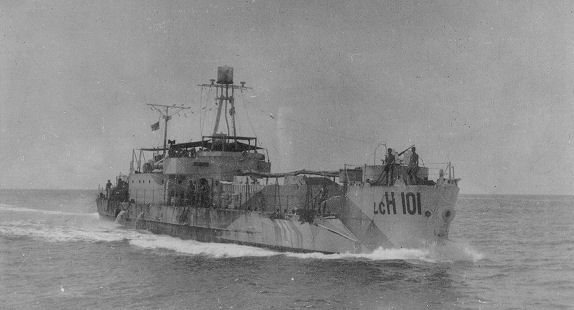Landing Craft Headquarters Ship

No badge issued for this vessel
Battle Honours
Malaya 1945
Specifications
Builder: New Jersey Shipbuilding Corp., Barber, New Jersey, United States
Displacement:
Light, 216 t.
Landing, 234 t.
Loaded, 389 t.
Length: 156 ft 5.5 in
Beam: 23 ft 3 in
Draught:
Light, 3' ft 1½ in mean
Landing, 2 ft' 8 in forward, 4 ft 10 in aft
Loaded, 5 ft 4 in forward, 5 ft 11 in aft
Propulsion: Two General Motors Quad units (4 General Motors 6051 series 71 Diesel engines per unit), driving twin variable pitch propellers, 2,320shp, 1 Quad unit per shaft.
Speed: 40 Knots
Cargo Capacity:
9 officers and 200 troops or 75 tons cargo - reduced by 50 troops after conversion.
Armament: Four single 20mm Oerlikon guns, mounted in tubs, one bow mounted, one mounted centrally on top of the superstructure aft of wheelhouse, one each port and starboard aft of superstructure.
Crew complement:
(LCI) 3 officers, 17 ratings
(LCH) 3 officers, 23 ratings
Commanding Officers
Not known
Related items
None
Reminiscences
None
Gallery
None
H.M.S. LCH-248

No images exist of LCH 248, this is her Sister ship LCH 101. Photo cutesy of Mr. Tony Bull
Early history
Ordered and delivered as a Landing Craft Infantry (Large) for the US Navy she was built by the New Jersey Shipbuilding Corp., Barber, New Jersey. She was laid down on October 22nd 1942, and launched November 21st 1942. She was transferred to the Royal Navy under the lend-lease agreement on December 17th 1942 at Staten Island, New York, and commissioned as HMLCI(L)- 248.
The ship next began four weeks of working up in the New York area, before sailing for Norfolk Naval Base, where she arrived at pier #3 on January 25th 1943 for repairs and alterations. Over the next two months she underwent the installation of plastic armour and sounding equipment, the fitting of sponsons and flareplates, repairs to hull, electrical system and main engines; she also received a replacement winch and pinace. She arrived at the Norfolk Shipbuilders and Drydock co. yard on January 29th for repairs, which were completed the following day. Before leaving Norfolk she was degaussed and calibrated at the Sewalls Point Magnetic Range, and visited the US Naval Ammunition Depot, St. Juliens Creek, Virginia, to embark small arms and gun ammunition .
She sailed for Gibraltar, via Bermuda on March 3rd, in company with LCI(L) 101, 103, 104, 105, 106, 108, 109, 110, 111, 113, 116, 119, 170, 182, 183, 184, 186, 240, 249, 251, 252, 254, and 256 . She was in action during the Invasion of Sicily, July 10th 1943 putting ashore men from the 51st Highland Division. On January 22nd, 1944 she took part in the amphibious landings at Anzio.
Conversion to a Headquarters Ship
On release from operations in the Mediterranean in the spring of 1944 she returned to the UK for conversion into an LCH, Landing Craft Headquarters. She underwent a period of modification which involved turning part of the troop decks into operations rooms and wireless offices, the installation of additional British command and control and communications equipment; 6 x Army No. 22 Radio sets; 6 X CDG, B28 receivers; 1 X CDF, B29 receiver. Echo Sounding type 763; 8 type visual signals (lanterns and torches); Type 970 Radar for navigation and control of assault craft; Outfit QH (Gee Hyperbolic Radio Navaid) 1 x TCS Transmitter. A tripod foremast was added to mount the additional aerials. In addition, single cabins were installed to accommodate assault force staff officers when embarked. When completed her troop carrying capacity was reduced by 50.
Reallocated to the East Indies Fleet
At the end of 1944 LCH 248 was allocated for service with the East Indies Fleet and sailed for India. After the D-Day landings plans were made to relocate large numbers of Major Landing Craft from the UK to the Eastern theatre under the code name ‘APPIAN’. Convoys of craft, referred to as ‘Flights’, sailed for India and Ceylon calling at Gibraltar, Port Said, Aden, and Bombay; the first Flight, ‘A’ sailed on November 15th 1944. It is not clear which flight LCH 248 sailed with or when she arrived in India.
No further information is available about her activities until she was allocated to participate in operation ZIPPER in September 1945.
Operation ZIPPER
After the Japanese surrender plans to accept the surrender of Singapore were put into action, originally this was part of Operation ZIPPER but political constraints meant that no landing could take place until after the signing of surrender in Tokyo on September 2nd, 1945. The delays meant that all plans were now to change; thus, the reoccupation of Malaya would take place in three phases. Phase one would be the recapture of Penang Island (Operation JURIST). Phase two would be the recapture of Singapore by the 5th Indian Division (Operation TIDERACE). Phase three would be the sea borne assault of North West Malaya in the Port Dickson, Port Swettenham area with landings near Morib with the 25th Indian Division and the 37th brigade of the 23rd Indian Division; this was a modified ZIPPER, carried out as planned and rehearsed, but the covering air and sea bombardment had been cancelled. The forces participating in these three operations were escorted by the Battleships NELSON, flying the flag of Admiral Walker, and RICHELIEU, the cruisers NIGERIA, CLEOPATRA, and CEYLON, with air cover from the 21st Aircraft Carrier Squadron, comprising of ROYALIST (Commodore Oliver) and the escort carriers HUNTER, STALKER, ARCHER, KHEDIVE, EMPEROR and PURSUER, and fifteen destroyers.
At 1200 hours on August 28th HM Ships NELSON, CEYLON, ATTACKER, HUNTER, TARTAR, PETARD, VOLAGE, PRINCESS BEATRIX and QUEEN EMMA arrived off Penang Island for Operation JURIST. On September 1st the C-in-C East Indies Fleet, Admiral Sir Arthur Power transferred from CLEOPATRA to NELSON at George Town, the official surrender of Japanese forces on Penang Island was signed on the 2nd. At 08:00 the following day 400 Royal Marines under the command of Lt. Colonel G B Grant were landed from the LSIs PRINCESS BEATRIX and QUEEN EMMA. This was Force Roma, formed in July from the Marine Detachments aboard NELSON, CEYLON, NIGERIA and PHOEBE.
At 0500 hours on the 8th NELSON in company with the light cruisers CEYLON and NIGERIA, escorted by destroyers NUBIAN, PALADIN and RELENTLESS sailed from George Town to cover the ZIPPER assault convoys on route to their assembly point off Port Swettenham: they were to be joined by the escort carriers EMPEROR, HUNTER, KHEDIVE, and STALKER to provide air cover for the landings.
LCH 101, 168 & 248 in company with LCI(L)s 115, 121, 127, 136, 183, 217, 256, 266, 277, 305, 311, sailed from Mandapam, India on August 31st in assault convoy JMD1C for Operation ZIPPER. Other convoys had sailed from Bombay and from Cochin, from Madras and Vizagapatam, from Calcutta and Chittagong and Rangoon. The ZIPPER assault convoys converged on the Malayan coast off Port Swettenham. Once assembled at first light on September 9th the ships of the assault convoys formed into two assault groups’ code named W 1 & W 2. As for DRACULA Senior Officer' Assault Group W1 was aboard HMS NITH and that of W2 aboard HMS WAVENEY. On reaching the lowering point off Morib the Assault Group Senior Officers transferred tot the LCHs, It is not clear which Landing Craft Headquarters were used by which assault group. The landings were not a success, numerous factors and mistakes made by the need to revise the plans several times resulted in stranded vehicles and ships; the beach survey was wrong, the sand was not suitable for heavy machinery which bogged down and blocked the beaches. The assault was actual an hour lite in its execution, Force W was operating on Ceylon time, not Burma time so the expected high tide had in fact ebbed. On September 12th a new beach was opened farther south, at Cape Rachado, where the 23rd Division landed without any of the difficulties met at Morib. By the time the beaches were closed, Morib on 25th and Cape Rachado on 28th September, 63,838 troops, 7,337 vehicles and 25,671 tons of stores had been landed over them.
HMS NELSON and much of the covering forces sailed for Singapore later on the 9th once the beach head had been establish, arriving there at 0830 hours on the 10th. Operation TIDERACE forces had arrived in Singapore on September 4th 1945, meeting no opposition. By 1800, the Japanese had surrendered their forces on the island to Lieutenant-General Sir Philip Christison aboard HMS SUSSEX. The formal surrender was finalised on September 12th at Singapore City Hall. Over 90 vessels were present in Keppel Harbour and Singapore Roads at the time of the surrender. It is unclear where LCH 248 went after her release from ZIPPER operations.
Post War history
Since LCHs could accommodate individual personnel they were employed transporting officers and medical teams up and down the coasts of India and Burma. In December some of the LCI(L) flotillas sailed to Cochin, others to Singapore, where many of the ships were decommissioned and the crews paid off.
LCH 248 was returned to US custody on May 4th 1946, probably at Manila. She was leased to France on January 26th 1948 and returned to US custody again on March 21st 1949. Later she was struck from the U.S. Naval Register and put up for disposal; her fate is unknown.
Last modified: 23 February 2023
Primary information sources
Additional sources:
NavSource Online: Amphibious Photo Archive
LCH-101 entry
www.uboat.net index of British and American
LCI(L)
navypedia.org RN AMPHIBIOUS SHIPS AND CRAFT
D-Day : The assault Allied Landing Craft and Ships
LCH specifications
Combined Operations Staff Notebook (1945)
Accessed July 2015
War Diaries: Found on
www.fold3.com
US Naval Ammunition Depot, St. Juliens Creek, Virginia,
U.S. Naval operating Base, Norfolk.
U.S. Naval operating Base, Bermuda.
U.S. Navy Yard, New York.
Admiralty War Diaries - various dates
Comments (0)